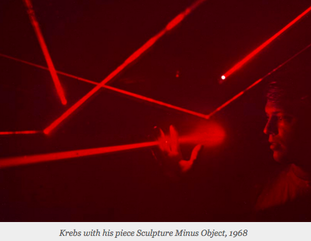
“After physicists first demonstrated the optical laser in May 1960, scientists and engineers started thinking of what they could do with it. So did artists.”
Archive Post: 12/27/2014
"After physicists first demonstrated the optical laser in May 1960, scientists and engineers started thinking of what they could do with it. So did artists." (For complete article by Patrick McCray click here.)
"Another notable effort was by Rockne Krebs, an American artist who made laser-based sculptures for several years starting in the late 1960s."
"Over time, Krebs expanded his focus from small-scale efforts using lasers in rooms and galleries to ambitious outdoor installations that incorporated building and landscapes into the work. Harking back – unconsciously, most likely – to Garmire’s experiments, his piece The Green Hypotenuse (1983) used a 7 mile-long laser beam that stretched from the observatory on Mt. Wilson down to Caltech."
"A key difference between Garmire’s “lasergrams” and installations made by artists like Krebs is the latter’s ephemeral nature. When the laser was turned off, the art disappeared. All that’s left are the sketches that went into its planning – “drawings for sculpture you can walk through” according to the title for one Krebs’ exhibit...."

